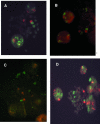Quantitative fluorescence in situ hybridization in lung cancer as a diagnostic marker
- PMID: 11272907
- PMCID: PMC1906883
- DOI: 10.1016/S1525-1578(10)60606-X
Quantitative fluorescence in situ hybridization in lung cancer as a diagnostic marker
Abstract
The diagnosis of lung cancer is quite often hampered by the existence of various cell types within samples such as biopsies or pleural effusions. We have established a new marker for image cytometry of interphase tumor cells of the lung by using the most recurrent and early cytogenetic event in lung cancer, the loss of the short arm of chromosome 3. The method is based on the detection of the imbalance between the long and the short arms of chromosome 3 by performing two-color fluorescence in situ hybridization on both arms. Fourteen tumors were analyzed after short-term culture and compared with the corresponding cytogenetic data obtained from metaphase analysis. Results on interphase nuclei and control experiments on metaphases were the same, with imbalance ratios ranging from 1.0 to 2.0 (mean value 1.6, median 1.5). To assess the clinical significance of this approach, three pleural effusions were analyzed. Data showed that normal cells within the sample could have been distinguished from the tumor cells based on different imbalance values between the long and the short arms. Thus, our method allows refined detection of lung tumor cells within samples containing heterogeneous cell populations.
Figures


Similar articles
-
Quantitative FISH by image cytometry for the detection of chromosome 1 imbalances in breast cancer: a novel approach analyzing chromosome rearrangements within interphase nuclei.Lab Invest. 1998 Dec;78(12):1607-13. Lab Invest. 1998. PMID: 9881960
-
Comparison between fluorescence in situ hybridization and classical cytogenetics in human tumors.Anticancer Res. 1998 May-Jun;18(3A):1351-6. Anticancer Res. 1998. PMID: 9673339
-
Quantitative fish determination of chromosome 3 arm imbalances in lung tumors by automated image cytometry.Med Sci Monit. 2004 Nov;10(11):BR426-32. Epub 2004 Oct 26. Med Sci Monit. 2004. PMID: 15507848
-
Molecular profiling of lung carcinoma: identifying clinically useful tumor markers for diagnosis and prognosis.Expert Rev Mol Diagn. 2007 Jan;7(1):77-86. doi: 10.1586/14737159.7.1.77. Expert Rev Mol Diagn. 2007. PMID: 17187486 Review.
-
Biological, molecular, and clinical markers for the diagnosis and typing of lung cancer.Immunol Ser. 1990;53:453-68. Immunol Ser. 1990. PMID: 1966068 Review. No abstract available.
Cited by
-
Quantitative analysis of centromeric FISH spots during the cell cycle by image cytometry.J Histochem Cytochem. 2013 Oct;61(10):699-705. doi: 10.1369/0022155413498754. Epub 2013 Jul 4. J Histochem Cytochem. 2013. PMID: 23832878 Free PMC article.
References
-
- Carbone D: The biology of lung cancer. Sem Oncol 1997, 24:388-401 - PubMed
-
- Sekido Y, Fong KM, Minna JD: Progress in understanding the molecular pathogenesis of human lung cancer. Biochim Biophys Acta 1998, 1378:F21-F59 - PubMed
-
- Testa JR, Liu Z, Feder M, Bell DW, Balsara B, Cheng JQ, Taguchi T: Advances in the analysis of chromosome alterations in human lung carcinomas. Cancer Genet Cytogenet 1997, 95:20-32 - PubMed
-
- Flüry-Herard A, Viegas-Péquignot E, De Cremoux H, Chlecq C, Bignon J, Dutrillaux B: Cytogenetic study of five cases of lung adenosquamous carcinomas. Cancer Genet Cytogenet 1992, 59:1-8 - PubMed
-
- Whang-Peng J, Kao-Shan CS, Lee EC, Bunn PA, Carney DN, Gazdar AF, Minna JD: Specific chromosome defect associated with human small-cell lung cancer. Science 1982, 215:181-182 - PubMed
Publication types
MeSH terms
Substances
LinkOut - more resources
Full Text Sources
Medical

